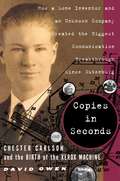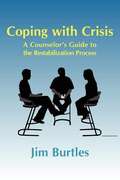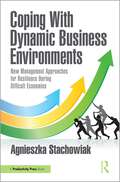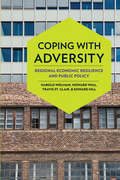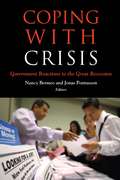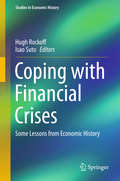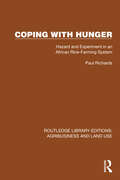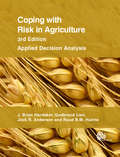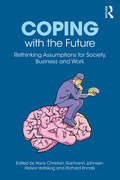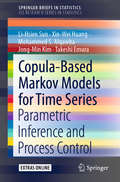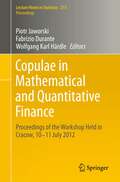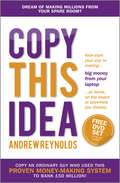- Table View
- List View
Cope with Change at Work: Teach Yourself Ebook Epub
by Clive Steeper Sue StockdaleIn these turbulent economic times it seems that change is now, ironically, the only constant. If you have found that your job has changed (or been lost) in ways that you cannot control, then this is the book for you. Whether it's your manager, your job, your employment status, your working style, or your industry that's changing, this book is full of practical tips. And it's not written just for managers either - this book is written for people who are going through change, rather than those who are trying to implement it.
Copies in Seconds
by David OwenA lone inventor and the story of how one of the most revolutionary inventions of the twentieth century almost didn't happen. Introduced in 1960, the first plain-paper office copier is unusual among major high-technology inventions in that its central process was conceived by a single person. Chester Carlson grew up in unspeakable poverty, worked his way through junior college and the California Institute of Technology, and made his discovery in solitude in the depths of the Great Depression. He offered his big idea to two dozen major corporations -- among them IBM, RCA, and General Electric -- all of which turned him down. So persistent was this failure of capitalistic vision that by the time the Xerox 914 was manufactured, by an obscure photographic-supply company in Rochester, New York, Carlson's original patent had expired. Xerography was so unusual and nonintuitive that it conceivably could have been overlooked entirely. Scientists who visited the drafty warehouses where the first machines were built sometimes doubted that Carlson's invention was even theoretically feasible. Building the first plain-paper office copier -- with parts scrounged from junkyards, cleaning brushes made of hand-sewn rabbit fur, and a built-in fire extinguisher -- required the persistence, courage, and imagination of an extraordinary group of physicists, engineers, and corporate executives whose story has never before been fully told. Copies in Seconds is a tale of corporate innovation and risk-taking at its very best.
Copies in Seconds
by David OwenThe first plain-paper office copier -- which was introduced in 1960 and has been called the most successful product ever marketed in America -- is unusual among major high-technology inventions in that its central process was conceived by a single person. David Owen's fascinating narrative tells the story of the machine nobody thought we needed but now we can't live without.Chester Carlson grew up in unspeakable poverty, worked his way through junior college and the California Institute of Technology, and made his discovery in solitude in the depths of the Great Depression. He offered his big idea to two dozen major corporations -- among them IBM, RCA, and General Electric -- all of which turned him down. So persistent was this failure of capitalist vision that by the time the Xerox 914 was manufactured by an obscure photographic-supply company in Rochester, New York, Carlson's original patent had expired. Xerography was so unusual and nonintuitive that it conceivably could have been overlooked entirely. Scientists who visited the drafty warehouses where the first machines were built sometimes doubted that Carlson's invention was even theoretically feasible.Drawing on interviews, Xerox company archives, and the private papers of the Carlson family, David Owen has woven together a fascinating and instructive story about persistence, courage, and technological innovation -- a story that has never before been fully told.
Coping With Crisis: A Counselor's Guide to the Restabilization Process
by Jim BurtlesIn the wake of a catastrophic event, the witness may discover or experience unsettling emotions which can trigger subsequent behaviors. These reactions can lead to a number of consequences, some of which are unproductive.
Coping With Dynamic Business Environments: New Management Approaches for Resilience During Difficult Economies
by Agnieszka StachowiakThis book discusses the existing management approaches for dealing with changes, namely readiness, maturity, and resilience. Although these concepts have been discussed for several years now, their importance grows when companies must deal with extended changes in economies. The changes are of a different nature: social, technological, and political, and they strongly impact every aspect of economies and companies’ activity. Is it possible to be ready for the changes? Should companies be resilient to disruption? These are the questions the managers are trying to answer, yet they need some support from academics. This book explores the synergy between the state-of-the-art knowledge and experience of companies to create a Contemporary Management Model. The scope of this book covers the methodology with an introduction and discussion of the key ideas and concludes with a presentation of the Contemporary Management Model followed by the practical validation and verification of the model based on case studies. This book is simply about developing the readiness and resilience of resources and processes, especially from a tactical perspective.
Coping with Adversity: Regional Economic Resilience and Public Policy
by Howard Wial Harold Wolman Travis St. Clair Edward HillCoping with Adversity addresses the question of why some metropolitan-area regional economies are resilient in the face of economic shocks and chronic distress while others are not. It is particularly concerned with what public policies make a difference in whether a region is resilient. The authors employ a wide range of techniques to examine the experience of all metropolitan area economies from 1978–2014. They then look closely at six American metropolitan areas to determine what strategies were employed, which of these contributed to regional economic resilience, and which did not. Charlotte, North Carolina, Seattle, Washington, and Grand Forks, North Dakota, are cases of economic resilience, while Cleveland, Ohio, Hartford, Connecticut, and Detroit, Michigan, are cases of economic nonresilience. The six case studies include hard data on employment, production, and demographics, as well as material on public policies and actions. The authors conclude that there is little that can done in the short term to counter economic shocks; most regions simply rebound naturally after a relatively short period of time. However, they do find that many regions have successfully emerged from periods of prolonged economic distress and that there are policies that can be applied to help them do so. Coping with Adversity will be important reading for all those concerned with local and regional economic development, including public officials, urban planners, and economic developers.
Coping with Crisis
by Jonas Pontusson Nancy BermeoThe financial crisis that erupted on Wall Street in 2008 quickly cascaded throughout much of the advanced industrial world. Facing the specter of another Great Depression, policymakers across the globe responded in sharply different ways to avert an economic collapse. Why did the response to the crisis—and its impact on individual countries—vary so greatly among interdependent economies? How did political factors like public opinion and domestic interest groups shape policymaking in this moment of economic distress? Coping with Crisis offers a rigorous analysis of the choices societies made as a devastating global economic crisis unfolded. With an ambitiously broad range of inquiry, Coping with Crisis examines the interaction between international and domestic politics to shed new light on the inner workings of democratic politics. The volume opens with an engaging overview of the global crisis and the role played by international bodies like the G-20 and the WTO. In his survey of international initiatives in response to the recession, Eric Helleiner emphasizes the limits of multilateral crisis management, finding that domestic pressures were more important in reorienting fiscal policy. He also argues that unilateral decisions by national governments to hold large dollar reserves played the key role in preventing a dollar crisis, which would have considerably worsened the downturn. David R. Cameron discusses the fiscal responses of the European Union and its member states. He suggests that a profound coordination problem involving fiscal and economic policy impeded the E.U.'s ability to respond in a timely and effective manner. The volume also features several case studies and country comparisons. Nolan McCarty assesses the performance of the American political system during the crisis. He argues that the downturn did little to dampen elite polarization in the U.S.; divisions within the Democratic Party—as well as the influence of the financial sector—narrowed the range of policy options available to fight the crisis. Ben W. Ansell examines how fluctuations in housing prices in 30 developed countries affected the policy preferences of both citizens and political parties. His evidence shows that as housing prices increased, homeowners expressed preferences for both lower taxes and a smaller safety net. As more citizens supplement their day-to-day income with assets like stocks and housing, Ansell's research reveals a potentially significant trend in the formation of public opinion. Five years on, the prospects for a prolonged slump in economic activity remain high, and the policy choices going forward are contentious. But the policy changes made between 2007 and 2010 will likely constrain any new initiatives in the future. Coping with Crisis offers unmatched analysis of the decisions made in the developed world during this critical period. It is an essential read for scholars of comparative politics and anyone interested in a comprehensive account of the new international politics of austerity.
Coping with Financial Crises: Some Lessons from Economic History (Studies in Economic History)
by Hugh Rockoff Isao SutoThis edited volume is based on original essays first presented at the World Economic History Conference, Kyoto, Japan, in August 2015. It also includes three essays subsequently written especially for this volume. All of the essays focus on financial markets in the periods leading up to, during, and after financial crises, and all are based on new data and archival research. The essays in this volume enlarge the range of historical evidence on the causes and potential cures for financial crises. While not neglecting the United States or Britain, the usual focus of financial historians, it includes studies of financial markets in times of crisis in Japan, Sweden, France, and other countries to achieve a truly global and historical perspective. As a result of the research reported here the reader will be made aware of several neglected factors that have shaped financial crises including the most recent crisis. These factors are (1) the role played by monetary policy in causing and ameliorating crises, (2) the role played by international contagion in private financial markets in propagating financial crises, (3) the role played by variations in the institutional structures of financial markets in determining the impact of financial crises, and (4) the role played by the social background of the central bankers who must contend with financial crises in determining the final outcome.
Coping with Hunger: Hazard and Experiment in an African Rice-Farming System (Routledge Library Editions: Agribusiness and Land Use #22)
by Paul RichardsOriginally published in 1986, Coping with Hunger demonstrates that effective agricultural development in resource-poor regions must be based in a respect for the indigenous farmer’s understanding of the environment. Based on participant-observation of rice farming in Sierra Leone, the book challenges the prevailing of attitudes of policy makers in the late 20th Century and restores indigenous culture and local wisdom to their rightful place. After analysing the fate of a number of ‘top-down ‘attempts to improve rice cultivation in Sierra-Leone the author derives an alternative agenda of research and development issues more closely reflecting the resource-poor farmers’ major interests and priorities. As a significant research-based contribution to the widespread general debates about the relevance of social factors in technological change, this book will be of interest to students in social and environmental sciences.
Coping with Retail Giants
by A. Coskun SamliIn the retail jungle dominated by giants like Walmart and Costco, survival for small and medium sized retailers will require a major shift from the traditional strategy of merchandise management to focus on generating customer value. Coping with Retail Giants critically analyzes the modern retail market and identifies how businesses gain the competitive edge over the major retailers that currently control the market. Samli argues that as society advances economically, consumers will seek better values generated by the retailing sector. This powerful stimulus will accelerate the retail revolution and be primarily carried out by entrepreneurial retailers-managers in small and medium sized retailing. Samli blends retail theory and practice to present a new model for retailing that delivers customer value, and ultimately, retail success.
Coping with Risk in Agriculture: Applied Decision Analysis
by J Brian Hardaker Ruud B Huirne Gudbrand Lien Jock R AndersonRisk and uncertainty are inescapable factors in agriculture which require careful management. Farmers face production risks from the weather, crop and livestock performance, and pests and diseases, as well as institutional, personal and business risks. This revised third edition of the popular textbook includes updated chapters on theory and methods and contains a new chapter discussing the state-contingent approach to the analysis of production and the use of copulas to better model stochastic dependency. Aiming to introduce agricultural decision making, probability and risk preference, this book is an indispensable guide for students and researchers of agriculture and agribusiness management.
Coping with Unplanned Absences
by Sarah CookWhen your organisation can no longer meet its deadlines, or provide customers with the high quality of service they expect, you have a problem. Unplanned absence also has a bad effect on morale, putting the rest of the team under pressure as they struggle to deal with the additional workload. Unplanned absence can occur as a result of force majeure (for example, when an airline is hit by strike action), or because of poor employee motivation and commitment. This pocket guide, based on best practice guidelines, looks at what you can do to ensure your employees fulfil their obligations and turn up as required. It then gets to grips with the question of how your organisation should handle unplanned absences before and when they arise. While you may not be able to prevent unplanned absence altogether, the advice contained in this guide will help you to keep the extra costs and disruption associated with unplanned absence to a minimum.
Coping with the Fast Track Blues: A Survival Guide for Your Climb to the Top
by Robert M. BramsonCoping methods that can help you deal with the personal and organizational barriers that frequent derail your climb, broad strategies for regaining a better balance between home and work, and more.
Coping with the Future: Rethinking Assumptions for Society, Business and Work
by Richard Ennals Halvor Holtskog Hans Christian Garmann JohnsenCoping with the Future has been written in response to widespread international awareness that the future is not predictable. In political and economic terms, we are in unknown territory, with daily developments around Brexit and the Trump Presidency, and "Kodak moments" in business. On the other hand, business leaders demand certainty, which is not available. This book redefines the nature of modern business. In contrast to recent trends, it has a focus on human-centred manufacturing and on decision-making which goes beyond a focus on short-term profit. The liberal capitalism of the USA and the UK is not the only current variety of capitalism. Business is not just about managers, but requires participation and engagement by workers. Since the financial crash of 2008, there has been much talk about the need for fresh approaches to business, but little has changed. This book pulls together current research and practice and poses new questions based on case studies. There is no one simple best way, but an uncertain future can be addressed, drawing on diverse past experience and cases. The book addresses an intended audience in business and universities, including business schools, around the world. The debate takes a broader approach, involving research in the social sciences and approaches from philosophy. The world has always been unpredictable, but we have allowed ourselves to be comforted by convenient myths. It is time to wake up.
Coping with the Global Financial Crisis: Challenges Facing Low-Income Countries
by Stefania FabrizioThis forthcoming title in the Departmental Paper Series describes the special challenges facing low-income countries as economic growth contracts by an estimated 1. 1 percent globally. Coping with the Crisis: Challenges Facing Low-Income Countries provides an assessment of the implications of the financial crisis for low-income countries, evaluates the short-term macroeconomic outlook for these countries, and discusses the policy challenges they face. Chapters cover the outlook for global economic growth and commodity prices, An overview of how low-income countries have been affected, fiscal policy, monetary and exchange rate policy responses, potential external financing needs and how the international community, including the IMF, can help countries meet them. The challenges ahead for low-income countries are delineated, including debt vulnerabilities and the need for countries to develop well-regulated local capital markets and banking systems, As well as enhanced public sector efficiency.
Coping with the Pandemic in Fragile Cities (SpringerBriefs in Applied Sciences and Technology)
by Gabriele PasquiThis book explores the effects of covid-19 crisis on cities and urban areas and proposes approaches and solutions to invert the pandemic's negative impact. The covid-19 crisis has had significant impacts on public health, on the everyday lives of millions of people, and on the use of urban spaces at all levels. All over the world, cities have been at the forefront of a crisis that have worsened socio-spatial inequalities between regions and inside urban areas. The book examines three aspects of the connection between pandemic and urban issues: the relevance of spatial and territorial variables in the explanation of pandemic dynamics and consequences in fragile cities; the assumption of radical uncertainty as the conceptual framework for a new approach to urban planning, in a phase of raise of public investments; and the design of urban policies aimed at facing the material and symbolic effects of pandemic on the practices of use of spaces and places, in a context characterized by a plurality of populations and forms of life.
Coping with the Stresses and Emotions: Becoming a New Manager Isn't Easy
by Linda A. HillBy necessity, new managers must work hard on themselves as they adapt to the challenges of managerial work and their new network of relationships. The move to management requires numerous changes: in the way you present yourself, in the way others treat you, and in the way you interact with new sets of people. Stress and other turbulent emotions are inevitable, and learning to deal with stresses and emotions may be as important to your career's success as your specific achievements at work. Author Linda A. Hill followed nineteen new managers through their first year, gathering data about the managerial transition. In this chapter, the managers describe in their own words some of the stresses and intense emotions they experienced during their transitions, as well as the mechanisms they developed for coping with stress-related problems in the workplace and in their lives outside of work. This chapter was originally published as Chapter 7 of "Becoming a Manager: How New Managers Master the Challenges of Leadership."
Coping, Personality and the Workplace: Responding to Psychological Crisis and Critical Events (Psychological and Behavioural Aspects of Risk)
by Cary L. Cooper Alexander-Stamatios AntoniouHow an individual responds to crises and critical incidents at work, both immediately and subsequent to the event, is heavily influenced both by personality characteristics and their use of coping strategies. These can, in turn, be affected by levels of education, gender and even the profession within which the individual is working. Coping, Personality and the Workplace offers theory, research and practice on our ability to cope with dangerous situations, critical incidents or other work crises. The chapters include perspectives on social and health habits and risks; gender and age differences as well as a range of different sources of threat: financial, psychological and physical; those within and outside the individual’s control; immediate and chronic. For organizations, this collection provides help and advice to build into employee safety and support programmes; for policy makers, a sense of the emerging sources of risk related to occupational health and for researchers, an anthology of original applied research from some of the leading authors in three continents.
Cops Under Fire: The Reign of Terror Against Hero Cops
by Larry McshaneEvery day, thousands of police officers willingly put their lives in danger to uphold their pledge to protect and serve the public. Once respected for their dedication and professionalism, police officers are now used as scapegoats-the victims of second guessing and racial issues. Allegations of excessive force and police brutality are rampant. Cases involving cops are more political, more scrutinized, and more explosive than ever before. Written in the years following the aftermath of the infamous Rodney King trial, Cops Under Fire is veteran Associated Press writer Larry McShane's probe into a series of high-profile cases involving police officers whose actions in the line of duty led to the questioning of their motives and ruining of their reputations.
Cops, Teachers, Counselors
by Michael Musheno Steven Maynard-MoodyWhether on a patrol beat, in social service offices, or in public school classrooms, street-level workers continually confront rules in relation to their own beliefs about the people they encounter. Cops, Teachers, Counselors is the first major study of street-level bureaucracy to rely on storytelling. Steven Maynard-Moody and Michael Musheno collect the stories told by these workers in order to analyze the ways that they ascribe identities to the people they encounter and use these identities to account for their own decisions and actions. The authors show us how the world of street-level work is defined by the competing tensions of law abidance and cultural abidance in a unique study that finally allows cops, teachers, and counselors to voice their own views of their work.
Copula-Based Markov Models for Time Series: Parametric Inference and Process Control (SpringerBriefs in Statistics)
by Takeshi Emura Li-Hsien Sun Xin-Wei Huang Mohammed S. Alqawba Jong-Min KimThis book provides statistical methodologies for time series data, focusing on copula-based Markov chain models for serially correlated time series. It also includes data examples from economics, engineering, finance, sport and other disciplines to illustrate the methods presented. An accessible textbook for students in the fields of economics, management, mathematics, statistics, and related fields wanting to gain insights into the statistical analysis of time series data using copulas, the book also features stand-alone chapters to appeal to researchers. As the subtitle suggests, the book highlights parametric models based on normal distribution, t-distribution, normal mixture distribution, Poisson distribution, and others. Presenting likelihood-based methods as the main statistical tools for fitting the models, the book details the development of computing techniques to find the maximum likelihood estimator. It also addresses statistical process control, as well as Bayesian and regression methods. Lastly, to help readers analyze their data, it provides computer codes (R codes) for most of the statistical methods.
Copulae in Mathematical and Quantitative Finance: Proceedings of the Workshop Held in Cracow, 10-11 July 2012 (Lecture Notes in Statistics #213)
by Fabrizio Durante Wolfgang Karl Härdle Piotr JaworskiCopulas are mathematical objects that fully capture the dependence structure among random variables and hence offer great flexibility in building multivariate stochastic models. Since their introduction in the early 1950s, copulas have gained considerable popularity in several fields of applied mathematics, especially finance and insurance. Today, copulas represent a well-recognized tool for market and credit models, aggregation of risks, and portfolio selection. Historically, the Gaussian copula model has been one of the most common models in credit risk. However, the recent financial crisis has underlined its limitations and drawbacks. In fact, despite their simplicity, Gaussian copula models severely underestimate the risk of the occurrence of joint extreme events. Recent theoretical investigations have put new tools for detecting and estimating dependence and risk (like tail dependence, time-varying models, etc) in the spotlight. All such investigations need to be further developed and promoted, a goal this book pursues. The book includes surveys that provide an up-to-date account of essential aspects of copula models in quantitative finance, as well as the extended versions of talks selected from papers presented at the workshop in Cracow.
Copy This Book!: What Data Tells Us about Copyright and the Public Good
by Paul J. HealdIn Copy This Book!, Paul J. Heald draws on a vast knowledge of copyright scholarship and a deep sense of irony to explain what's gone wrong with copyright in the twenty-first century. Distilling extensive empirical data to clearly show the implications of copyright laws and doctrine for public welfare, he illustrates his findings with lighthearted references to familiar (and obscure) works and their creators (and sometimes their creators' oddball relations). Among the questions he tackles: How does copyright deter composers from writing new songs? Why are so many famous photographs unprotected orphans, and how does Getty Images get away with licensing them? What can the use of music in movies tell us about the proper length of the copyright term? How do publishers get away with claiming rights in public domain works and extracting unmerited royalties from the public? Heald translates piles of data, complex laws, and mysterious economics, equipping readers with the tools for judging past and future copyright law.
Copy This Idea: Kick-start Your Way To Making Big Money From Your Laptop At Home, On The Beach Or Anywhere You Choose
by Andrew ReynoldsCOPY AN ORDINARY GUY WHO USED THIS PROVEN MONEY-MAKING SYSTEM TO BANK £50 MILLION! Have you ever dreamed of escaping the 9-5 rat race? Of working part time at home just a few hours a week, yet making more money in a month than you make in a whole year now? Of starting on a shoestring and going on to bank your first £million? Of having the freedom and the money to live the life you truly want and deserve? Follow in the footsteps of this ordinary down-to-earth guy who actually did just that! He gave up his job and starting in from his spare room at home, became a multi-millionaire despite having never done anything like this before. Now for the first time, in this book, he will show you how you can copy his proven money making system. You will even receive a free DVD set to help you along the way! "AMAZING. I buy something for £6, just like he showed me, and sell it for £197...working from my kitchen table at home. Even though I'd never done anything like this in my life, I have pulled in over £1million so far." Andrew Reynolds' student.
Copy This!: Lessons From A Hyperactive Dyslexic Who Turned A Bright Idea Into One Of America's Best Companies
by Paul Orfalea Ann MarshBill Moyers said this about Paul Orfalea after reading Copy This!: "If I could live my life over again, I would sit at his feet and listen to everything he has to say. " And David Brancaccio, host of NOW on PBS, wrote: "As the host for a decade of a daily business program, I had to read what seemed like every business book published in the English language. It is, therefore, with authority that I can say Paul Orfalea's book is wonderful, heartbreaking, and profoundly useful. " <P><P> Copy This!, Paul Orfale's memoir of turning lemons into lemonade, is wise, personal, funny, unflinchingly honest, and filled with wisdom, business lessons, and his inspired Orfalea Aphorisms. It's the story of how a struggling kid who could barely read, write, or sit still managed to grow a 100-square-foot copy shop named Kinko's into a $1. 5 billion empire that Fortune named one of the best places in America to work. And it's the story of an individual who saw his learning disabilities-ADHD and dyslexia-as learning opportunities, which molded the homegrown, compassionate culture that allowed Kinko's to thrive, and guided the behavior of a CEO who had no choice but to think different. A terrifically entertaining read from a born storyteller, but with the hardcore guts of true business acumen, Copy This! will blow fresh air into the thinking of any manager, entrepreneur, executive, or business owner.

